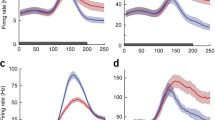Abstract
It has been suggested that the mammalian memory system has both familiarity and recollection components. Recently, a high-capacity network to store familiarity has been proposed. Here we derive analytically the optimal learning rule for such a familiarity memory using a signal- to-noise ratio analysis. We find that in the limit of large networks the covariance rule, known to be the optimal local, linear learning rule for pattern association, is also the optimal learning rule for familiarity discrimination. In the limit of large networks, the capacity is independent of the sparseness of the patterns and the corresponding information capacity is 0.057 bits per synapse, which is somewhat less than typically found for associative networks.
Similar content being viewed by others
References
Amit D (1989) Modeling brain function: the world of attractor neural networks. Cambridge University Press, Cambridge
Bogacz R, Brown MW (2002) The restricted influence of sparseness of coding on the capacity of familiarity discrimination networks. Network 13(4): 457–485
Bogacz R, Brown MW (2003) Comparison of computational models of familiarity discrimination in the perirhinal cortex. Hippocampus 13: 494–524
Bogacz R, Brown MW, Giraud-Carrier C (2001) Model of familiarity discrimination in the perirhinal cortex. J Comput Neurosc 10: 5–23
Brunel N (1994) Storage capacity of neural networks: effect of the fluctuations of the number of active neurons per memory. Phys A 27: 4783–4789
Dayan P, Willshaw DJ (1991) Optimising synaptic learning rules in linear associative memories. Biol Cybern 65: 253–265
Fortin NJ, Wright SP, Eichenbaum H (2004) Recollection-like memory retrieval in rats is dependent on the hippocampus. Nature 431: 188–191
Hertz J, Krogh A, Palmer RG (1991) Introduction to the theory of neural computation. Perseus, Reading
Hopfield JJ (1982) Neural networks and physical systems with emergent collective computational abilities. Proc Natl Acad Sci 79: 2554–2558
Horner H (1989) Neural networks with low levels of activity: Ising vs. McCulloch-Pitts neurons. Z Physik B Condens Matter 75(1): 133–136
Kanter I, Sompolinsky H (1987) Associative recall of memory without errors. Phys Rev A 35: 350–392
Meunier C, Nadal JP (1995) Sparsely coded neural networks. In: Arbib MA (eds) The handbook of Brain theory, 1st edn. MIT press, Cambridge
Nadal JP, Toulouse G (1990) Information storage in sparsely coded memory nets. Network 1: 61–74
Tsodyks MV, Feigelman MV (1988) The enhanced storage capacity in neural networks with low activity level. Europhys Lett 6: 101–105
Willshaw DJ, Buneman OP, Longuet-Higgins HC (1969) Non-holographic associative memory. Nature 222: 960–993
Yakovlev V, Amit DJ, Romani S, Hochstein S (2008) Universal memory mechanism for familiarity recognition and identification. J Neurosci 28(1): 239–248
Yonelinas AP (2001) Components of episodic memory: the contribution of recollection and familiarity. Proc R Soc B 356: 1363–1374
Author information
Authors and Affiliations
Corresponding author
Rights and permissions
About this article
Cite this article
Greve, A., Sterratt, D.C., Donaldson, D.I. et al. Optimal learning rules for familiarity detection. Biol Cybern 100, 11–19 (2009). https://doi.org/10.1007/s00422-008-0275-4
Received:
Accepted:
Published:
Issue Date:
DOI: https://doi.org/10.1007/s00422-008-0275-4




